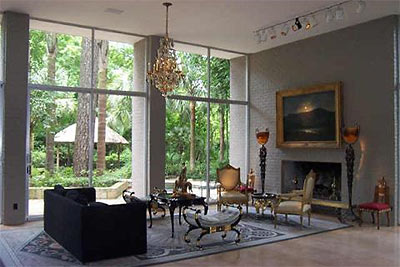
Judging from its debut in this morning’s demolition report, it’s looking like the end of the line for the classic 1960 steel-and-glass home at 6040 Glencove St., near Bayou Bend and Memorial Park.
What’s going away?
The house had the kind of wide-open spaces that modernists love, and its floors were marble Рcool, [original owner Andr̩] Crispin says, under bare feet in the summer.
At 4,600 square feet, the house was large for its era, plenty big enough for the Crispins’ four children and their grand-scale entertaining. When Crispin and his wife hosted musical events, 200 to 300 guests thronged their dramatic living room. There, those guests could admire the wall of glass 14 feet tall. It offered a view of the untamed back yard, a rolling ravine filled with sassafras trees, rabbits and armadillos.
The home was designed by Houston architect Talbott Wilson, 2 years before his firm created the Astrodome. Its current owner, David Mincberg, was appointed by Mayor White earlier this week to serve on the board of commissioners of the Houston Housing Authority. Mincberg bought the property last spring from an owner-broker who employed an innovative marketing plan: the Midcentury Modern came free with purchase of the dramatic 1.35-acre homesite.
What did Mincberg end up paying?
***
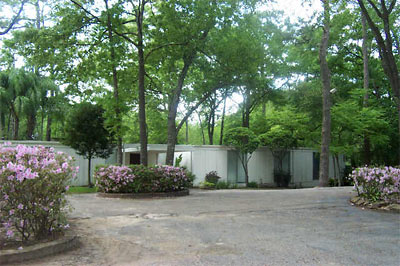



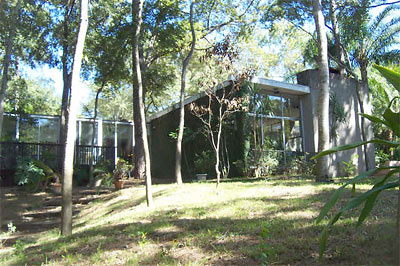

HAR’s public portal generally provides price ranges for recent home sales, but strangely displays no record at all of Mincberg’s purchase from owner-broker Richard Maier.
Maier’s sales strategy worked, though: Apparently, the land was attractive to Mincberg — the freebie not so much. Last summer, while telling voters he hoped would elect him as County Judge that he’d “do everything possible” to save the Astrodome from demolition, Mincberg told the Chronicle‘s Lisa Gray that he had different intentions for the house:
During the option period, Mincberg had it inspected twice. He says his inspectors found termites, foundation troubles, mechanical problems, “you name it” – major problems he says render the house unlivable. But instead of leaving those problems to some other buyer, he closed the deal, with plans to tear the house down and build something new on its lot.
For a time — after Mincberg lost the election to incumbent Ed Emmett in the fall — those plans appeared to have changed. According to a posting on Realtor.com, Mincberg put the house back on the market in December. In March, he got permits for repairs and alterations to the property. In June, the house’s relisting, the remodeling of its kitchen, and what one commenter termed the home’s new “bad stucco job” were topics of discussion on HAIF.
Realtor.com still displays the home’s most recent listing — with Martha Turner Properties, for $2,695,000. But that offer appears to have ended recently, in time for the home’s demolition.
- 6040 Glencove St. [Realtor.com]
- A home and the Dome [Houston Chronicle]
- Talbott Wilson House [HAIF]
- Mayor White appoints former County Judge candidate to job [Houston Political Blog]
- Free! Classic Midcentury Modern Home Included with Purchase of Property! [Swamplot]
- Glen Cove Mod: So Much for Freebies [Swamplot]
Photos: sellModern (top); HAR (all others)



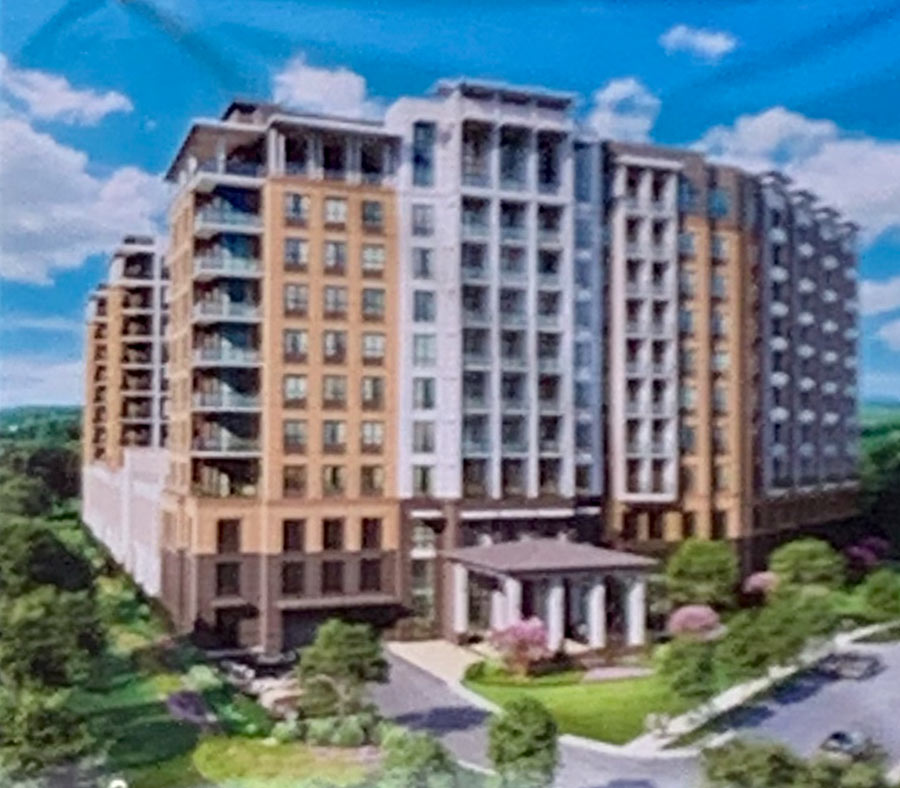
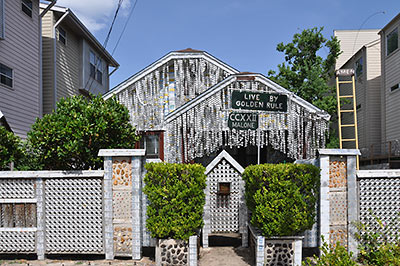
It’s a shame but it’s his house and his house to tear down if he chooses.
Architecturally significant means nothing in Houston as everyone saw in the demolition of the McDermott house on Lazy Lane. If it can happen on Lazy Lane, it can happen anywhere.
There is always the excuse of termites and foundation problems and other structural and mechanical problems but in reality most of the homes were built to survive all of the above with a little tender care and a little tender renovation.
The owner just wants the land on an exlusive street in an exclusive neighborhood in order to build a “I’m richer than you are” monstrosity. And they are always monstrosities when compared to what they replaced. With all the talk about “appropriateness” and “scale” you would think someone would mention the architectural disasters being permitted by the city rather than just the hirises.
Let’s be glad David Mincberg didn’t become county judge. He might have changed his mind about the Astrodome as well.
I could cry!WOW…what an awesome house…It almost makes me ill when I read something like this…I wish Mincberg could flex his money muscles and do the house justice by bringing back to it’s glory…he should consider it a piece of art that he just invested in… such a shame..wish I had the “dough”…I’d outbid him and save it!
‘Vive la différence’ is about all one can say…
Imagine a future time of less personal wealth & greater population density when this house would be universally appreciated for its soaring spaces & extroverted personality – a House of its Time.
To ll of you wanting to “preserve” older houses: have any of you ACTUALLY “preserved” an old house. They’re expensive money pits,that sometimes,in the end ,because, of outrageous cost have to be torn down. Old houses are suck up money.And for all of you that want to save an old house,good luck getting any bank to loan YOU money. Old houses have MANY issues: crakced foundations / rotting piers/beams,out dated systems(HVAC,plumbing,electrical,etc. They’re VERY expensive to replace.And you DO NOT get 100% of your investment back upon resale. Go refurbish and old,”charming” house with “character” and see how much MONEY it costs you. This is after all a country where people can do what THEY want with THEIR property,NOT what some of you fascist property Nazis want to have appointed your selves the neighborhood dictators. MIND YOUR OWN BUSINESS!!!
I’m pretty sure that you can express the desire that an architecturally significant house should not be demolished without being a “property nazi” Tim. I have to admit the idea that a property built in 1960 is an “older” home is kind of funny to me but maybe thats just because I’m not a native.
Interestingly, of my acquaintances the ones whose homes are the biggest money pits are the ones who bought 2-5 year old properties. The original owners sold as soon as the warranty ran out and the new owners are left carrying the can for poor initial construction.
Tim – that hasn’t been our experience at all. Not only were we able to get financing to renovate our older homes, but we also got a healthy return on our investment (in one case, we sold the house for over double what we paid for it – even factoring in the money we had to put into it, it was a terrific investment). While I agree that doing a proper renovation is not cheap, if you find a good property and work with good contractors, it’s less expensive in the long run than tearing down and starting from scratch. Of course, you have to have something decent to start with – but solid old construction is pretty hard to beat.
Of course, you have to have something decent to start with – but solid old construction is pretty hard to beat.
_________________________________________
And that of course always belies the “money pit” excuse with regard to many of the architecturally significant homes. They were and are indeed solid construction. Meant to last.
In other parts of the country many of these older homes and architecturally significant homes are holding their value despite significant devaluation in the market as a whole.
Of course in other parts of the country people respect their history and attempt to preserve it. Here we tend to demolish it for something newer and flashier.
And in most cases, something quite tacky.
Homes for people with more money than taste. If they had taste, they would renovate the original home.
Matt,
Amen.
I’ve been in this house and despite the history and pictures did not find the plan layout particularly inspiring or suitable for updating. Some odd shaped rooms that did not take great advantage of the spectacular lot. There were also some structural problems with the foundation which one might expect for a house of this vintage perched on the side of a hill. I think these items probably contributed to the demise of this house.
Don’t get me wrong, I’m all for preservation, but ‘solid old construction’ does not describe most 1950’s and 1960’s houses built in the Houston area. Cracked foundations requiring frequent visits from Olshan, extremely poor lumber quality with large knots in the boards that would never pass today’s lumber grading standards, porous adobe brick, aluminum wiring, rattling aluminum windows, galvanized pipe that leaves little flakes of rust in your shower head and cracks under your slab, RCP sewage waste lines that flow the wrong direction due to settling in the soil, no insulation in the walls, flat roofs that don’t slope properly due to settlement, and on and on. I find the post-war-pre-city-of-Houston-building- code construction generally of poor quality in the Houston area. You have to go back to the 1920’s and 1930’s to find good quality structures.
One renovates these houses, as I have, for reasons other than financial, and in my opinion despite the ‘quality construction.’
Tim…. YES a bank will lend money … I am a Realtor..and it is done all the time..the loan is called a 203K loan and many investors “preserving” properties use them…This type of project here on this blog..is probably hugely expensive..and someone with a lot of cash could take it on.. and…believe it or not, some people do it for the love of architecture and don’t care whether or not they get “all their money back”…some renovate, reburbish….to stay in the property…. again..I if I had the “dough”…I would certainly take this on!
Tim-
Yes, I have renovated an old home. Twice in fact. Curently in on that is pushing the century mark. It is not uncommon. Simmer down. Each case is unique. But it is odd that somone who can afford more than two and a half million for a lot cannot afford to renovate.
All over Europe people live in homes built before our nation even existed and millions of Americans go there because they want to see history.
Matt is right. “Can’t be renovated” is a very convenient excuse; can’t is a matter of opinion.
And I disagree with Mincberg on another point – I think we should blow up the Astrodome.
MT,
As with all things, I guess it depends on where you’re looking. I’m currently living in a 1950’s era home that was built like a bunker (but more attractively, of course) – with the exception of wiring and a few new windows, all of the changes we made when we moved in were cosmetic.
Of course, sweeping statements about new or old construction are just generalizations – there is crummy old construction in Houston, just as there is solid new construction. My personal experience with older homes in Houston has been extremely positive, whereas a lot of the newer construction I’ve seen has been pretty shoddy.
I “have … ACTUALLY “preserved†an old house.” Three in fact. “They’re expensive money pits,that sometimes,in the end ,because, of outrageous cost have to be torn down.” But I slugged through the renovations. “Old houses are suck up money… Old houses have MANY issues: crakced foundations / rotting piers/beams,out dated systems(HVAC,plumbing,electrical,etc. They’re VERY expensive to replace.And you DO NOT get 100% of your investment back upon resale.” I usually got 150 – 200% back. “Go refurbish and old,â€charming†house with “character†and see how much MONEY it costs you.” It’s fun and, once complete, rewarding.
Thanks for reminding me, tcpIV.
This old house I live in? Recently had it apprased and my increase is about 15%/ year. Not a bad return. Yes, I put $ into it, but I also got to live someplace I really liked. I am not at all disapointed with my ROI. Sure has done better than my IRA. Blanket statements about never getting back your money are simply silly. It depends.
We own a mid-century modern home and, yes, there are expenses that we might not have had with a new home. But my home has personality that my previous house, a circa 2002 Montrose townhome, completely lacked. Most new construction homes in Houston look alike, and are sterile. I prefer the quirks of my MCM. But I know most people in this town wouldn’t agree.
I have owned mid-century homes both 20th & 19th, and I have to disagree with the quality of the lumber or workmanship. Old houses need updating, but you can ask any real estate attorney which involves more lawsuits, old houses or new constructions.
Assuming the property has not had any infrastructure updates (plumbing, electrical wiring, etc.) and assuming basic home maintenance was differed — as it often is — for say, 40 to 50 years, a reasonable rule of thumb for renovation costs would be equal to the purchase price (key word in that phrase is “reasonable”). Better to assume worse case when considering restoration/renovation work. Economy of scale certainly helps and in this case 4600 s.f. may help maximize dollars spent. However, this would be a very large project and would benefit from having an architect not only perform due diligence, but oversee the remediation effort. Yep, more cost there too. Bottom line, this $2695000 initial purchase would probably end up at $5500000 (conservatively). Do the neighborhood comps measure up? If not, will they in the near future? Does it even matter if owning a “piece of history” is your benchmark? The last question is rhetorical… of course.
JAH,
Renovation costs equal to purchase price? Where are you getting those estimates? I’m not a renovation professional (so this is anecdotal), but neither of my renovations cost that much – and yes, we hired architects for both.
Before we bought our house, we looked at many houses ranging from the 1930’s – 1950’s and consulted with architects for all of them. Renovation cost estimates were nowhere close to 100% of the purchase price.
But yes, I’ll agree with you, the price of the house post renovation is definitely a factor. If you can’t get a good deal on the house that allows for wiggle room with renovation costs, then the economics might not work (and in that case, it is more of an emotional pull to renovation than a financial one).
Has anyone seen that monstrosity at the corner of Memorial and Westcott?
It may not mean much to “the bottom line”, but when someone saves a house like this one, by one of Houston’s top mid-century architects, he/she becomes a hero to a lot of people. He/she learns a lot about life, and he/she becomes the owner of something really special. I know a lot of people don’t quite understand the value in something like that, but it really is amazing to consider the value of hearing people say “I love your house! Thank you for saving it!” or “People like you make Houston special!” Unfortunately, many of Houston’s best mid-century modern homes are/were built on incredible properties that have over time become much more desirable than the homes themselves. It’s a pretty tough obstacle for preservationists, especially those on a budget, to overcome.
Like I said to someone else, wonderful piece of property. However, conducting real estate transactions with rose colored glasses on is rather foolish. I have lived in and renovated several types of properties over the years, with the oldest being built in 1919.
Cost effective renovation is very difficult for many people because they are either not capable of doing some or any of the work themselves, they do not have the professional contractor contacts to do the remodel properly, or the condition of the property and/or structure don’t make fiscal sense for a remodel/renovation.
Let’s be clear, many dwellings have been so neglected for so many years, they are not worth saving, especially when coupled with the fact that it was not an attractive, interesting house to begin with. That does not mean that there are not a lot of great renovation prospects all around Houston. It just takes the right type of renovation/remodeling team AND property/structure. I know there are a lot of tree hugging looney tunes out there with no common sense that are going to insist that some governmental social engineering (channeling Peter Plan Brown) planning agency needs to tell us all exactly what we can and can’t do with our own property, but those types of principles are not what this country was founded upon, much less what Houston was founded upon. (Oh, and I’ll bet you I’ve planted more trees than anyone reading any of this.)
While there are certainly more than too many unscrupulous builders and developers running around this world, there is almost nothing worse than some planning nazi with an axe to grind, no cognitive reasoning abilities and a social engineering agenda to shove down the public’s throats.
Property rights are important. Prudent building codes are generally a good thing too, when practiced in moderation. Imposing land use restrictions upon property owners is a very precipitous path to tread down. Be careful what you ask for.
You, can build just about anything if cost is no object. However, cost is almost always part of the equation. Prudence usually rightfully wins out over “feelings” and vanity. It’s hard to make “feelings” look like they have a place on a balance sheet or a cost justification.
The piece of property in question here is an awesome parcel. However an aging, neglected, largely ugly house in major disrepair most likely would be better off being demo’d with a good builder/architect starting from scratch. With a price tag as high as it is, quality construction should be the end result. However, there is no guaranty on most things in life, especially when and architect and a builder are involved.
Architecture in general is so different in the states than anywhere else. Where I am from the Architect is the boss and in most cases even signs his name somewhere on the exterior. Here, however the architect (if there is any) gets $400 for the plan and is really in no way involved in the building process, leaving it up to the mindless builder. ::sigh::
“Renovation costs equal to purchase price? Where are you getting those estimates?”
Amen!
I guess if you hired the first person you saw in the phone book for every little thing, but come on!